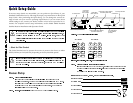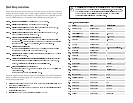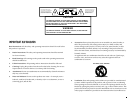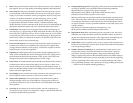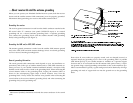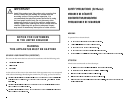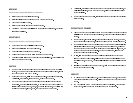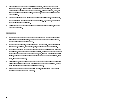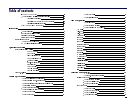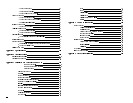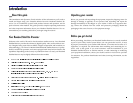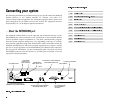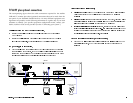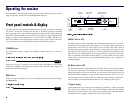
9. Heat: This product should be located away from heat sources such as radiators,
heat registers, stoves or other products (including amplifiers) that radiate heat.
10. Power Sources: This product should be operated only from the type of power
source indicated on the marking label. If you are not sure of the type of power
supply in your home or business, consult your appliance dealer or local power
company. For products intended to operate from battery power, or other
sources, refer to the operating instructions supplied with the product.
For applications other than in North America, a suitable attachment plug
adapter should be used for connection to the power source. For determining the
appropriate attachment adapter type, refer to qualified technical personnel.
11. Polarization: This product may be equipped with a polarized alternating cur-
rent line plug (i.e., a plug having one blade wider than the other). This plug will
fit into the power outlet only one way. This is a safety feature. If you are unable
to insert the plug fully into the outlet, try reversing the plug. If the plug should
still fail to fit, contact your electrician to replace your obsolete outlet. Do not de-
feat the safety purpose of the polarized plug.
12. Power Cord Protection: Power-supply cords should be routed so that they are
not likely to be walked on or pinched by items placed upon or against them,
paying particular attention to cords at plugs, convenience receptacles, and the
point where they exit from the appliance.
13. Lightning: For added protection for this product during a lightning storm or
when it is left unattended and unused for long periods of time, unplug it from
the wall outlet and disconnect the antenna or cable system. This will prevent
damage to the product due to lightning and power-line surges.
14. Power Lines: An outside antenna system should not be located in the vicinity of
overhead power lines or other electric light or power circuits, or where it can
fall into such power or circuits. When installing an outside antenna system, ex-
treme care should be taken to keep from touching such power lines or circuits as
contact with them might be fatal.
15. Overloading: Do not overload wall outlets, extension cords or integral conven-
ience receptacles, as this can result in a risk of fire or electric shock.
16. Object and Liquid Entry: Never push objects of any kind into this product
through openings as they may touch dangerous voltage points or short-out
parts that could result in a fire or electric shock. Never spill liquid of any kind
on the product.
17. Servicing: Do not attempt to service this product yourself as opening or re-
moving covers may expose you to dangerous voltage or other hazards. Refer all
servicing to qualified service personnel.
18. Damage Requiring Service: Unplug this product from the wall outlet and refer
servicing to qualified service personnel under the following conditions:
(a) When the power-supply cord or plug is damaged.
(b) If liquid has been spilled, or objects have fallen into the product.
(c) If the product has been exposed to rain or water.
(d) If the product does not operate normally by following the operating instruc-
tions. Adjust only those controls that are covered by the operating instructions
as an improper adjustment of other controls may result in damage and will of-
ten require extensive work by a qualified technician to restore the product to its
normal operation.
(e) If the product has been dropped or damaged in any way.
(f) The product exhibits a distinct change in performance.
19. Replacement Parts: When replacement parts are required, be sure the service
technician uses replacement parts specified by Scientific-Atlanta, or parts hav-
ing the same operating characteristics as the original parts. Unauthorized part
substitutions made may result in fire, electric shock or other hazards.
20. Safety Check: Upon completion of any service or repairs made to this product,
ask the service technician to perform safety checks to determine that the product
is in safe operating condition.
21. Outdoor Antenna Grounding: If an outside antenna or cable system is con-
nected to this product, ensure that the antenna or cable system is properly
grounded to provide protection against voltage surges and built-up static
charges. Appropriate sections of the National Electrical Code (NFPA 1990) pro-
vide information with respect to proper grounding of the mast and supporting
structure, grounding of the lead-in wire to an antenna discharge unit, connec-
tion to grounding electrodes, and requirements for the grounding electrode (see
“…About receiver & satellite antenna grounding”).





